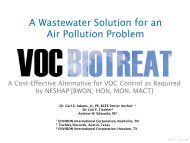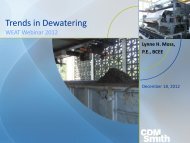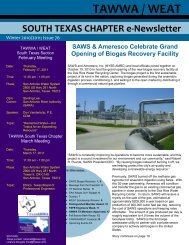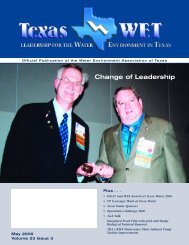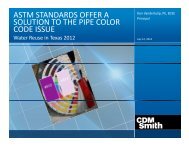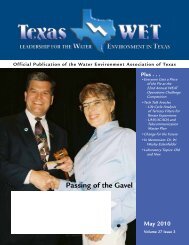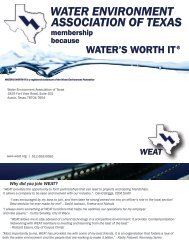4 | <strong>Texas</strong> WET March 2009A Message from the PresidentBy Betty Jordan, PresidentHappy New Year! Funny thought for May. ButWEAT’s new year begins right after <strong>Texas</strong> <strong>Water</strong> whennew <strong>of</strong>ficers start their terms and TX <strong>Water</strong> takes place inApril – so… Happy New Year! When I was in school, thenew year actually started in September – the new schoolyear. Fiscal years can begin any month. Kind <strong>of</strong> makesyou wonder how real time truly is. New years usuallyencourage reflection, assessment, and vision. So I’mgoing to start this year with some reflections.ReflectionsLooking back, we’ve just had a great <strong>Texas</strong> <strong>Water</strong>Conference. In spite <strong>of</strong> fears that last year’s hurricaneand the recent downturns (plummeting) <strong>of</strong> the economywould make for a bleak conference, we came very closeto matching the attendance that we had at our recordbreakingconference in San Antonio last year. Some havesuggested that <strong>Texas</strong> <strong>Water</strong>, like WEFTEC nationally,is such an integral part <strong>of</strong> our industry that people feelthe need to attend regardless <strong>of</strong> economic conditionsor other situations. Perhaps so. It is certainly a timefor us to come together as an industry – clean andwastewater sides – and share lessons learned and plansfor the future. Hats <strong>of</strong>f to Galveston and its remarkablerecovery.<strong>Texas</strong> <strong>Water</strong> means something different to eachindividual. No way can I comprehensively addressthe many wonderful aspects <strong>of</strong> the conference in thiscolumn. But I would like to talk about three specificareas which are near and dear to my own heart and inwhich I have been greatly encouraged recently: youngpr<strong>of</strong>essionals, the awards breakfast, WEAT committees,and then in July I will address <strong>Water</strong> for People.Young Pr<strong>of</strong>essionalsAs an organization and an industry, we areextremely fortunate with the qualities <strong>of</strong> young peoplewho are moving in to take over (yikes! Is this a badthing?) leadership in WEAT and in our firms eventually.I have been bowled over by their enthusiasm andcreativity in developing their own tech session, designcompetition, receptions, parties (and more partiesand more parties), sections, and awards. Bravo forTrooper Smith, this year’s emerging leader award winner,for his role in initiating the design competition andthen handing it over to a colleague in a great display<strong>of</strong> delegation. Trooper has shown leadership withinWEAT as well as his “day job” in which I’ve had theprivilege <strong>of</strong> watching him lead project meetings and bethe peacemaker between a group <strong>of</strong> SPs with strongopinions. And Trooper is not unique among our YPs.What a joy to watch the creativity with which theyapproach engineering projects as well as service projectsand WEAT projects. Let us SPs work together to givethem a leg up and encourage them in their endeavorsand not get in their way. If only we could come up witha way <strong>of</strong> cloning them!!!The term OF is being replaced by a somewhatmore polite term – SP (seasoned pr<strong>of</strong>essional). That’sprobably a better term than OF but coming from <strong>Texas</strong>,the term seasoned pr<strong>of</strong>essional makes me think <strong>of</strong> somebig slab <strong>of</strong> meat ready for the BBQ grill rather than anexperienced engineer. Oh well.Awards CeremonyOh what a morning! Bravo to Mike Howe for aninteresting, inspiring, fun … what else can we say ….morning <strong>of</strong> awards. I was actually sorry when the awardsceremony ended. That’s never happened before. Whatfun to see the people behind the awards! What fun tosee glimpses into their families. Tears came into my eyeson several <strong>of</strong> the awards where cities and river authoritieswent to the rescue and aide <strong>of</strong> Galveston. Aren’t we agreat industry?!WEAT CommitteesIn case you haven’t noticed, the WEAT committeestructure has undergone some very significant renovationduring the last few years. You can find the list <strong>of</strong>committees at www.WEAT.org or at the end <strong>of</strong> thismagazine. These are areas in which you can becomevery involved, particularly some <strong>of</strong> the knowledgecommittees. Recently, I observed the <strong>Water</strong> QualityCommittee respond quickly to a call for commentson proposed nutrient criteria. Emails whirled backand forth; experts from all over the state were adding,deleting, and modifying a well-written and organizedseries <strong>of</strong> statements on the proposed criteria. The finaldocument – one in which we can all take pride -- wassubmitted to the legislature. The same thing happenedon the bacteria standards. WEAT will soon be hosting(June 12th) a webcast on the proposed standards.This is what we’re about – providing good technicalinformation related to the pertinent issues <strong>of</strong> the day.How exciting it is to see it coming together and workingthe way it is supposed to.<strong>Water</strong> <strong>Environment</strong> <strong>Association</strong> <strong>of</strong> <strong>Texas</strong> and <strong>Texas</strong>Section <strong>of</strong> AWWAWe are a wonderful group with a great history anda dynamic future. Look around you. Thank those whohave helped, encouraged, or inspired you. Go and dolikewise to someone else. Be a part <strong>of</strong> what is happeningthis year. Check out your opportunities to plug inat www.weat.org or on the association page <strong>of</strong> thismagazine.
May 2009 <strong>Texas</strong> WET | 5WET Tech TalkTrinity River Authority Peak WetWeather Management SystemBy Dawn R. Anderson, PE (CP&Y, Inc.),Bill Tatum (Trinity River Authority),David Jackson (Freese and Nichols) andBetty Jordan (Alan Plummer Associates, Inc.)IntroductionThe Trinity River Authority <strong>of</strong> <strong>Texas</strong> (TRA) hasevaluated the need to upgrade the treatment plantcapacity to accommodate projected peak wet weatherflows. The Design Team developed and evaluatedalternatives for the management <strong>of</strong> peak wet weatherflows to the Trinity River Authority’s Central RegionalWastewater System (CRWS) plant.Previous inflow and infiltration evaluations onthe collection system feeding the TRA CRWS plantdemonstrated that by the year 2020, projected two-hourpeak flows could reach 623 MGD. The facility, as it iscurrently constructed, is permitted for a peak two-hourflow <strong>of</strong> 405 MGD and average flows <strong>of</strong> 189 MGD, butcan only biologically process 340 MGD for a sustainedperiods during extended wet weather flows. Excess flowsabove the two-hour peak flows are currently stored in theexisting equalization basins.Wet Weather Flow Treatment EvaluationIn a separate study, CP&Y evaluated several highratetreatment technologies, such as enhanced high-rateclarification, high-rate biological treatment, high-ratefiltration, and disinfection for potential use in developinga management plan for handling the full range <strong>of</strong> flowsprojected as influent to the CRWS plant.CPY also evaluated the quality <strong>of</strong> influent duringpeak wet weather events. It was predicted that solubleBOD and ammonia serve as the base organic loadingat the facility. Results for tests run during wet weatherevents produced a BOD loading within one percent <strong>of</strong>the dry weather loading. The Design Team found similarresults with ammonia loading.Feasibility StudyThe Design Team conducted a feasibility studyevaluating the use <strong>of</strong> an existing borrow pit, located inthe plant’s West Landfill for the <strong>of</strong>f-line storage <strong>of</strong> wetweather flows, to reduce or eliminate the need to expandthe treatment plant to accommodate extreme peakflows. The study also addressed required modificationsto the existing system to provide additional operationalflexibility in routing peak flows to storage. Wetweather flows could eventually be treated by high-rateclarification, which would supplement the existingprimary clarifiers, producing high quality effluent suitablefor storage.The Team performed a cost versus volume analysisto determine the most cost-effective basin volume basedon the size <strong>of</strong> the existing borrow pit. The basin volumerequiring the least amount <strong>of</strong> modification to the existingpit, such as excavation and backfill, yielded the smallestconstruction cost. The analysis demonstrated that theleast expensive basin configuration has a total volume <strong>of</strong>125 MG.HydrographAs a part <strong>of</strong> the feasibility study, the Design Teamdeveloped a hydrograph for a year 2020 design storm.Historical data was used in conjunction with projectedpeak two-hour flow data to develop a hydrograph thataccurately depicted the magnitude and duration <strong>of</strong>flows entering the plant during a wet weather event. Thishydrograph shows that during wet weather events, flowto the plant will rise and maintain a higher than averageflow for two or more days.Based on the design storm hydrograph, 100MG <strong>of</strong> total storage volume available in the existingequalization basins and the on-site storage basin wouldallow a sustained flow through the treatment processContinued on page 6• <strong>Water</strong> & Wastewater Treatment Plants• Lift Stations & Force Mains• Hydraulic Modeling• Detention/Retention Ponds• Pump Stations & Tanks• Pipeline Design• Master PlansJohn Lindner, P.E.Public WorksManaging Principal512.328.0011 TEL512.328.0325 FAXjlindner@burypartners.comAustin | Dallas | Houston | San Antonio | Temple | TEXAS



